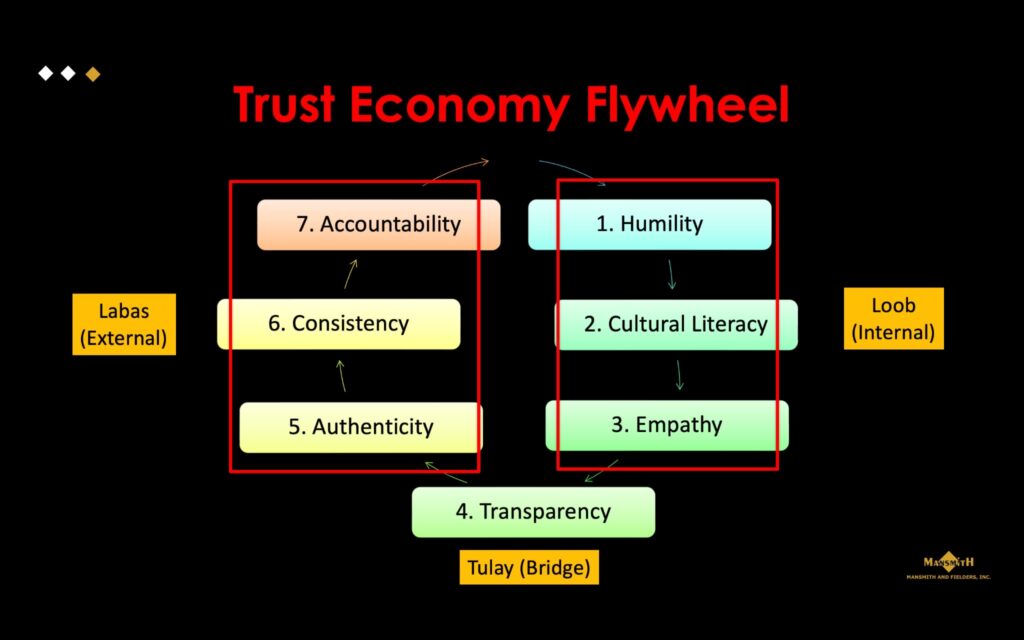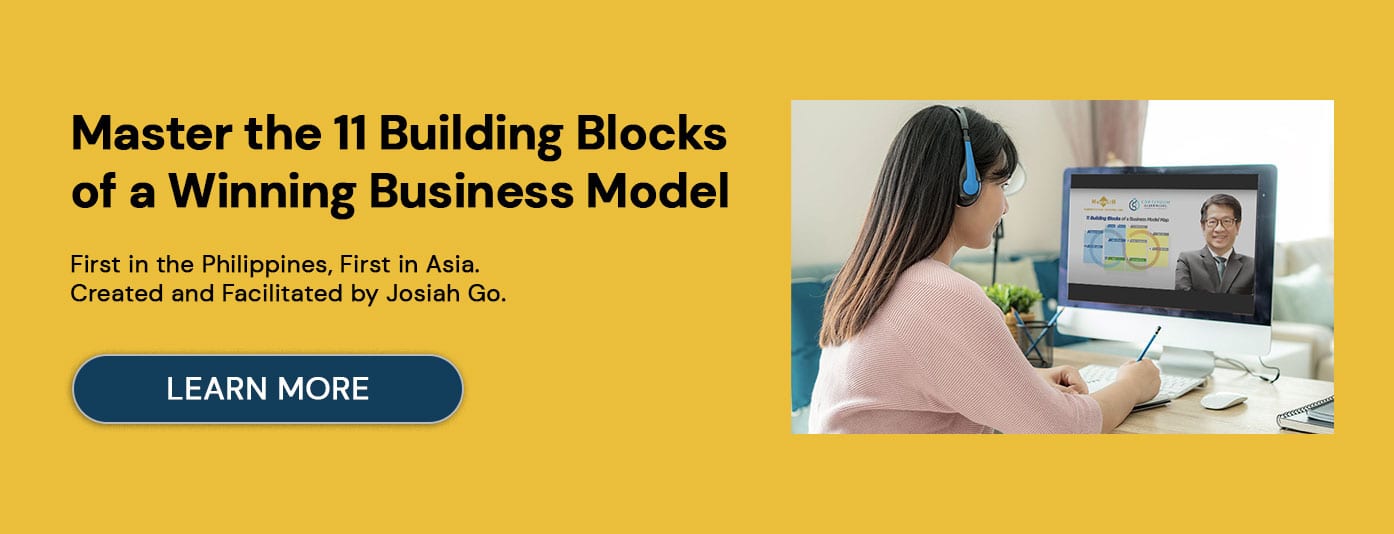
Years ago, a marketing manager approached me and asked, “Sir Josiah, how do we market trust when people already assume the worst of us?”
It was a question I had no quick answer for; and I’ve always believed that important questions deserve more than quick answers. It was not a question about branding, not really. It was a question about character. About broken systems. About what happens when people no longer believe us, not just because of failed promises, but because of patterns of behavior that repeatedly break trust.
That moment became a turning point. It led me down a path of deeper listening and broader reflection, not just as a marketer or strategist, but as a Filipino, a citizen, a leader, and most of all, a student of behavior.
That journey resulted in what I now call the Trust Economy Flywheel: a values-based, culturally grounded, and action-oriented framework that I co-developed with anthropologist Chiqui Escareal-Go for rebuilding moral leadership and institutional integrity in a time when skepticism has become the default.
The Shift to a Trust Economy
Today, we no longer live in a purely transactional economy. People do not choose brands, organizations, or leaders based solely on price, reach, or need. We live in a Trust Economy, where choices are shaped by values, reputation, cultural fit, and perceived integrity.
In this new economy, trust is the new currency. It determines whether people will buy from us, vote for us, partner with us, or disengage entirely.
In the old model, authority was enough. Titles carried weight. Institutional power demanded respect. Today, those assumptions no longer hold. Authority may still open doors, but it is character that keeps them open.
Trust Begins From Within: The Power of Loob
In the Filipino psyche, we often speak of loob (inner self or inner integrity) and labas (outward expression). The Trust Economy Flywheel is built on this insight: that true trust begins in the loob, not in image, but in intention. Not in strategy, but in identity.
Loob means Cultivating the Trust Within:
- Humility: the self-awareness of a steward. Humility is not about thinking less of oneself, but about seeing oneself clearly, as a steward of trust, not its owner. It is the inner discipline of recognizing one’s power without being possessed by it. A humble leader is self-aware enough to know when to step forward and when to step aside, when to speak truth and when to listen deeply. This is stewardship — leading not for personal gain, but in service of something larger than the self.
- Cultural Literacy: the courage to understand and transform our own norms. To build trust, we must understand the emotional and cultural realities that shape how people relate to power. Filipino values like hiya, delicadeza, and utang na loob are often misunderstood, labeled as barriers to accountability. But when we reclaim them with integrity, they become moral compasses. Utang na loob reminds us that public service is a relationship, not a transaction. Hiya can awaken ethical sensitivity, not fear. Delicadeza can restore dignity to leadership. Cultural literacy also means having the courage to confront norms that enable silence, favoritism, or impunity, transforming culture from a shield for wrongdoing into a force for accountability.
- Empathy: the discipline of presence. Empathy is more than feeling for others; it is feeling with them. It asks leaders to be fully present: to see, hear, and sense the realities that data alone cannot capture. Sympathy observes; empathy participates. It listens not to respond, but to understand without assumption. In times of disillusionment, empathy transforms authority into solidarity and power into partnership
Loob is the quiet work of integrity, cultivating the inner life that makes trust possible. It is what shapes how we act when no one is watching, and how we lead when everything is at stake.
Transparency: The Bridge Between Belief and Behavior
If loob is the engine of trust, then transparency is the bridge. It connects inner integrity to outer credibility.
Without it, people speculate. They fill in the gaps with suspicion, often, justifiably so.
Transparency is not merely about publishing reports or releasing data.
It is about making our processes, intentions, and values visible, not after decisions are made, but as they are made. It’s not just access to information, but access to the logic behind our decisions.
Imagine if public infrastructure projects were managed with radical transparency, not by uploading documents post-completion, but through real-time, publicly accessible dashboards: contract bidding histories, pricing breakdowns, photo documentation, contractor performance metrics, GPS-tracked progress, audits, and citizen feedback mechanisms, all secured through blockchain (or equivalent) for traceability.
This is not fantasy. This is operationalized trust.
When technology is designed with integrity, it reduces power asymmetry.
It empowers citizens, clients, and communities.
It builds trust into systems, making it resilient beyond political cycles or leadership transitions.
Transparency turns belief into behavior, the unseen promise of loob into the visible practice of labas.
The Labas: Making Trust Visible
If loob is how we lead ourselves, and transparency is how we connect, then labas is how we are seen, the outward expression of integrity. It is where others experience whether our inner values are real.
In this phase, trust is demonstrated through:
- Authenticity: coherence between message and messenger. People are tired of polished statements that conceal messy realities. Authentic leadership doesn’t curate perfection; it embodies honesty. The message must match the messenger. We earn trust when we speak plainly, live openly, and act consistently with our values, even when it costs us.
- Consistency: reliability in the ordinary. Trust is not built in moments of crisis; it’s built in the quiet, repetitive choices that show people they are safe with us. It’s not performance that sustains trust, but principle. Consistency tells people: you can rely on me, even when no one is watching.
- Accountability: courage in imperfection. Leadership is not about optics; it is about outcomes. And when things go wrong, as they always do, accountability is the test. Do we name the issue, face the consequence, and repair the damage? Or do we spin the narrative, shift the blame, and protect the brand?
Trust does not grow in perfection. It grows in the honesty of our repair.
Why Trust Is Hard to Rebuild
Rebuilding trust is not only a leadership challenge, it is a behavioral one. Human psychology is not always rational. People carry the memory of betrayal more vividly than the experience of success.
- Confirmation bias makes people look for signs that they were right to doubt us.
- Status quo bias makes people resist change, even when change is real.
- Loss aversion means that people are more afraid of losing again than they are hopeful of gaining something new.
This means that rebuilding trust must go beyond communication, it must involve behavioral design, empathy-driven systems, and consistency over time.
The key is not to persuade, but to show, align, and repeat.
The Real Cost of Lost Trust
When trust erodes, the consequences are not abstract. They are economic, social, and deeply personal.
- Public projects stall because communities resist.
- Brands lose loyalty and struggle to recover.
- Citizens disengage from democratic processes.
- Transaction costs rise because due diligence replaces goodwill.
We must realize that mistrust is not just a moral failure, it is a developmental roadblock.
Every day that trust remains low, we lose opportunities to collaborate, innovate, and build.
A Hybrid Model of Leadership
The future of leadership is not binary. It is not a choice between Filipino values and Western systems. The best leaders, today and tomorrow, will likely be culturally hybrid. They will:
- Adapts communication based on audience and purpose
- Draws from Western traits like directness and transparency
- Rooted in Filipino values: relational harmony, humility, and empathy
This is not compromise. It is wisdom. Leadership in the Trust Economy is not about choosing a style, it is about aligning with purpose and adapting with integrity.
A Call to Lead Differently
We often think that trust is earned in big moments, in times of crisis or success. But the truth is that trust begins in the small things: keeping a promise, telling the truth, choosing people over optics, staying present when it’s inconvenient, and doing the right thing even when there’s no applause.
Rebuilding trust doesn’t start with others. It starts with us. It starts with asking, What small act of integrity can I commit to today, consistently, from the inside out?
In families. In organizations. In communities. In government. In ourselves.
We do not need to wait for perfect systems or heroic leaders. We need everyday leaders who choose humility over pride, accountability over image, consistency over convenience.
Trust is a Cycle
The Trust Economy Flywheel is not a checklist. It is not a campaign. It is a cycle, a living model that builds momentum as each part reinforces the others.
It reminds us that trust is not built on perfection, but on alignment.
And when that alignment exists, from loob to labas, across behavior, communication, and systems, trust doesn’t need to be demanded. It is freely given, because it has been earned.
In a time when institutions are questioned, and words are cheap, let us lead with a deeper kind of wealth.
Let us lead with trust.


